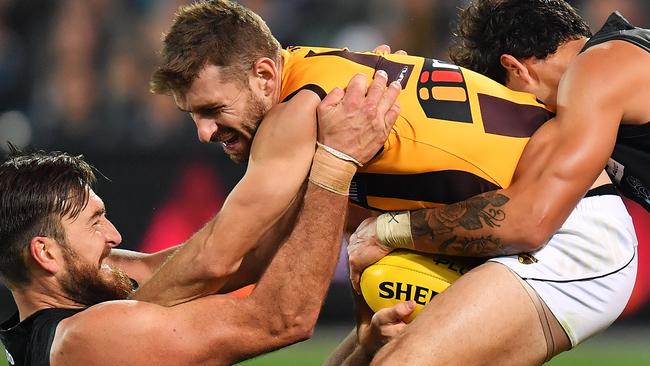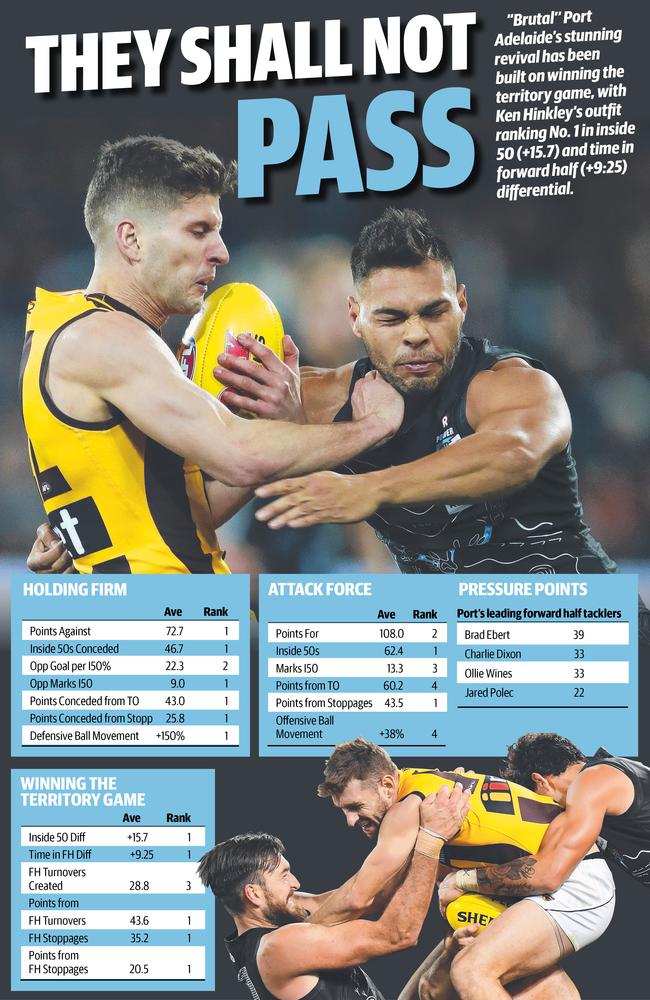How “brutal’’ Port Adelaide is winning the territory game against its AFL rivals
PORT Adelaide’s success has been built on pressure and territorial advantage with the club leading the AFL in inside 50 and time-in-forward-half differential.

Andrew Capel
Don't miss out on the headlines from Andrew Capel. Followed categories will be added to My News.
“I LOVE that strong defensive football when we lock the ball in our forward half. The ball did not look like getting through us.’’
With those words, coach Ken Hinkley summed up Port Adelaide’s record-breaking first half against Hawthorn last week when it held Alastair Clarkson’s team - triple premiers from 2013-15 - to its lowest-ever half-time score of 0.3.
“That was pretty brutal football, wasn’t it, when you can do that to a side like Hawthorn who were coming off a really strong win (against Sydney).
“You’ve got to be really pleased with that.’’
The Power’s stunning first half summed up just how well it is playing the territory game and why it has risen from non-finalist in consecutive seasons to genuine flag threat this year.
It is the blueprint for the club’s success.
No side has controlled play like Port has in the first half of the season.

After allowing Hawthorn just 26 inside 50s at Adelaide Oval last Friday while penetrating its own forward 50 64 times, the Power illustrated how its pressure game is paying big dividends.
The numbers are compelling.
After round 11, Port ranked a clear number one in inside 50 and time in forward half differential — two key pointers to success.
Its inside 50 differential of +15.7 is nearly seven more than the next-ranked side Collingwood (+8.9).
Its time in forward differential of +9:25 is more than two minutes greater than the next-best team Richmond (+7:22).
In other key territory game pointers, the Power ranks first in points from forward half turnovers (43.6), forward half stoppages (35.2) and points from forward half stoppages (20.5).
Overall, it leads the competition in average inside 50s (62.4) and is second in points scored (108).
Defensively, Port ranks number one in points conceded (72.7) and inside 50s conceded (46.7).
As good as the Power’s back half has been this season, a chief reason for its ability to stop the opposition scoring is that the game is being played in its half of the ground.
Port has taken an all-in approach to defence and the players have bought in.
Even when it was outscored in the second half by the Hawks last week, Hinkley felt his side was playing the game on its terms.
“We still had a lot of forward 50 stoppages, a lot of tackles,’’ he said. “We still has the ball in our half, where we would like it, but just didn’t have the polish (to finish off the work).’’

Once the Power gets the ball in its half of the ground it just doesn’t let it out.
This enables it to get repeat scoring opportunities while allowing it to set up its pressing game which in turns protects its defence.
“We pride ourselves on our team defence,’’ said Power captain Travis Boak.
“We did a lot of work on it during the off-season. The big thing was making sure teams don’t score against us on turnovers.
“Right now we sit as the best defensive side in the competition but we still feel that we’ve got a lot of improvement in that area.
“We need to make sure that we bring four quarters of defence – both offensively and defensively – if we’re going to beat the best teams.’’
Key forward Charlie Dixon – a revelation in his second season at Port — has played a key role in the Power becoming forward half ball hogs.
He and Geelong’s Tom Hawkins lead the AFL in forward half tackles among key forwards, with 33. Midfielder Brad Ebert – enjoying a career-best season – leads Port in forward half tackles with 39 ahead of fellow onballer Ollie Wines (33) and Dixon.
Dixon is the Power’s leading inside 50 tackler with 21.
“We just love mowing opponents down with a tackle,’’ small forward Jarman Impey said.
The proof is in the pudding!


